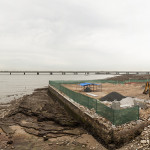Christmas holidays have come to an end, it’s time to leave our annual retreat and go back to work. I need to leave my village and its rural environment in Baixo Miño in Galicia, to face a city like Barcelona, which sometimes is… let’s say, complicated. Specially after two weeks of nature and tranquility. And since abusive air fares to Vigo airport for Christmas “force” us to fly via Porto, isn’t it a better idea to make a break in a medium town like this? So… Done!
I call an old fellow student who has moved to Porto to boost his career as a graphic designer and in just a couple of minutes, we have a meeting point and time. Knowing his way to get involved with his environment, I have no doubt I’ll get to his favourites spots.
Now it’s time to see how to get to Porto from the Baixo Miño. Porto is a city we often must rely on if you live in southern Galicia. Not only because of its airport, but also for shopping, gastronomy or Swedish furniture shops. As low cost flights arrived to Porto, the bus company Autna began offering two trips a day from Vigo to Porto airport. In addition, they prolonged the line to the center of Porto and added a stop in Valença (at the border with Spain). Things got interesting and the airport sums nowadays over 50 direct destinations, so the buses run now 5 times per day. In addition, the new highway along the coast (now with a -complicated for road virgins- pay system), allows them to stop also at Vila Nova de Cerveira, a village connected by a bridge to the Baixo Miño (indeed, our first hidden gem lies on its surroundings).
Sounds good, right? But there is a con: the weekend. There is only one bus a day to get to Porto in winter, two in summer. So, for those like me who want to spend Sunday there, an alternative is needed: the (slow) train. But well, as there are many frequencies, we can even have breakfast in the center of the historic town of Vila Nova de Cerveira and start the mouth watering with some “Natas Lisbon” and a fantastic Portuguese coffee.
And well, there’s no secrets about trains. Or maybe yes. The train arrives on time, even before time to make way for the train coming in the opposite direction. Many areas in the region have a single track, so any delay can affect the entire network. However, the Portuguese railway company has already got busy inflating time to recover minutes if necessary. In fact, it is not uncommon to stand 4-5 minutes in almost every stop. The train takes 1 hour 40 minutes to get to Porto because of this awkward infrastructure that separates the 100 kilometers from Vila Nova de Cerveira. Yes, the slow path lets you assimilate privileged landscapes such as the Minho river at its inception, Mountain Santa Tecla on the other side of the river from Caminha, or the windy atlantic waves in northern Portugal. Even for a moment one may consider to take off at Viana do Castelo to savour some Sidonios. The train slowly separates from the coast and gets into the mainland along foggy hills, valleys and gardens that fit the track running through the villages.
In short, a leisurely tour to enjoy. A journey that whet your appetite for more Portugal, a destination that is even today for many, a hidden gem in itself. A big gem I hope to show you in the coming months.








Comments by d_lopezalvarez